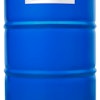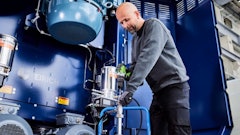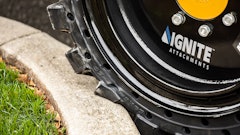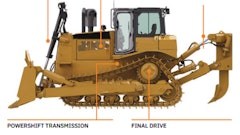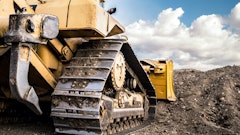It's that time of year again. Leaves fall, the days get shorter and temperatures drop. In some areas, cooler temperatures are a welcome retreat from the 100-plus degree dog days of summer. But in other areas, the mercury plummets enough to wreak havoc on equipment and, ultimately, efficiency.
Some adjustments you may need to make relate to the type of hydraulic fluid used in your equipment. Extreme temperatures - either cold or hot - can have a significant impact on hydraulic oils. If the ambient temperature is above or below the operating ranges of the selected fluid, efficiencies can decrease, oxidation rates can increase and you can ultimately experience damage to the pump and/or the machine.
Keep fluid in the cold
While equipment manufacturers provide both oil type and viscosity grade recommendations for hydraulic fluid selection, there are certain factors you should consider to ensure you're using the right fluid for the conditions.
At the top of the list is viscosity. "The correct oil viscosity is critical to protecting that expensive hydraulic pump - which the owner is concerned about - and giving the machine operator the hydraulic performance he needs to get the job done," says Walt Silveira, director of industrial products at ConocoPhillips.
This requires close attention to viscosity index ratings. "The hydraulic oil properties must remain as constant as possible regardless of temperature changes," says Brian Schmidt, construction and mining sales manager, ChevronTexaco. "The oil must maintain a high viscosity index. The higher the viscosity index, the better the oil performs in wide temperature changes."
Other properties to monitor include the pour point (temperature at which the fluid will remain a liquid), foam resistance, rust protection and demulsibility (ability of the oil to separate from water). Also pay attention to oxidation resistance, thermal stability (for higher than normal operating temperatures) and anti-wear properties.
In addition, you will have to weigh the cost vs. benefits when selecting hydraulic fluids. Synthetics cost more than mineral-oil based products. But in some applications, such as arctic environments, they may be your only option. In extreme cold, where the thermometer routinely drops below zero - such as Alaska and even northern parts of the United States - fluidity becomes the critical issue.
Synthetics have a much broader temperature band, typically about -50° to 350° F compared to 5° to 225° F for mineral oil-based products. This is partly because they are wax-free. As oil cools, the wax crystals solidify, thickening the oil and preventing it from pouring or pumping. "Since synthetics are wax-free, they have much better low-temperature properties than hydraulic oils that are mineral-oil based," says Silveira.
As equipment sits idle in cold environments, fluid temperatures drop to ambient levels. They become thick, and pumpability is reduced. "If the hydraulic fluid becomes too cold or too thick, it won't flow," says Silveira.
"This lack of flow can cause damage to the pump - the hydraulic system operates very sluggish and, if severe enough, fails to operate at all."
It's the startup temperature that is most critical. "If you're in an area where temperatures drop below zero, and your equipment sits overnight, you'll need to factor in what the cold startup condition will be and ensure that your hydraulic oil meets your temperature, OEM and performance needs," says Schmidt.
Some contractors in arctic conditions also turn to heater cores to keep fluids warm during downtime, eliminating cold startups.
Michael Quinn, technology manager for engine and machine fluids at Caterpillar, also suggests warming up the hydraulic system before putting it into full action. "Exercise the hydraulics," he says. "With no load, and with the engine at less than one-third throttle, slowly raise, lower, extend and retract the boom. Move the boom inches at first, extending the travel during each cycle. Get the fluid flowing before you put a load on it."
"Once the engine starts and the working of the oil generates heat, your hydraulic fluid will provide proper lubrication," adds Silveira.
Options for beating the heat
While synthetics may be the only choice in extreme cold, you have a few more alternatives when working in intensely hot environments. Multigrade and heavier (thicker) petroleum-based products join synthetics as options when the mercury rises above 120° F.
High ambient temperatures dictate a change in fluid selection because they make it more difficult for the cooling system to dissipate heat generated when the oil is being worked. In some applications, fluids can easily reach 200° F.
"There's no place for that heat to go because the outside temperature is so hot," says Quinn. "And any time a petroleum-based oil is over 230° F for any length of time, it will suffer."
Randy Pinkston, owner of Straight Line, Inc., is all too familiar with working in severe environments. His company does house footings and plumbing for residential homes in the Las Vegas, NV, area. During the summer months, it isn't uncommon for his crews to work in ambient temperatures that consistently reach 110° to 116° F. In many instances, that means hydraulic fluid temperatures can reach 260° F.
"We run all newer machines so we have to stay within the manufacturer specifications for hydraulic fluids or else we void the warranty," he says. "Most of the time, those recommendations are for straight-grade fluids. But in many cases, we've served as a proving ground for companies to develop additives to extend the life of hydraulic fluids used in extreme applications such as ours."
Pinkston's most common problem related to heat occurs when the fluid breaks down and tarnishes the system. "It's almost like it develops a wax on the inside of the cylinders," he explains.
This is a common problem in high-temperature operations, notes Silveira. The excessive heat accelerates oxidation and thermal breakdown. As a general rule, a mineral oil's life is cut in half for every 15°° F rise in temperature above 155° F.
Because synthetics have a higher temperature band (up to 350° F), they can be a good choice in this situation. "Synthetics don't thin out as quickly as they heat up," says Silveira. "In some cases, they can help with added viscosity at high temperatures. They don't break down as easily so you won't get sludge and deposits. Plus, they'll last longer.
"The primary concern is that the majority of mobile equipment doesn't have a large enough reservoir that allows the oil to recover from a cycle through the system," Silveira continues. "The oil doesn't have enough time to cool down and drop out any contamination such as moisture, wear particles and dirt."
The result is that in extremely hot environments (indoors and out) oil oxidizes more rapidly. It tends to thicken, which shortens the oil change interval.
It also becomes very thin. "The oil viscosity is what protects the pump. When the fluid is too thin, the metal components in the pump start to wear against each other," explains Silveira. "A contractor experiencing abnormal pump repairs in hot conditions needs to consider evaluating the lubricant in service."
"When you get outside of the normal temperature ranges, either hot or cold, you need to watch the oil," agrees Quinn. "And you'll know when you've gone too far. You'll suffer some sort of efficiency problem first.
Things will get slower, and won't work as well. At the extreme end, you may have a failure. You'll need to ask yourself if the oil viscosity grade you're using is the optimum choice for your ambient temperature. At the extreme ends, you'll need to do something different."
How to Go to the Extremes
Tips for construction equipment hydraulic systems
Latest in Oils, Lubricants & Greases

